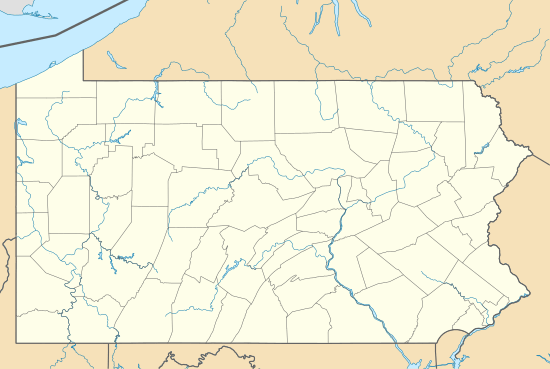GoggleWorks
|
Willson, Thomas A. and Co. | |
|
| |
  | |
| Location | 201 Washington St., Reading, Pennsylvania |
|---|---|
| Coordinates | 40°20′20″N 75°56′9″W / 40.33889°N 75.93583°WCoordinates: 40°20′20″N 75°56′9″W / 40.33889°N 75.93583°W |
| Area | less than one acre |
| Built | 1871 |
| Architect | Muhlenberg Brothers |
| Architectural style | Moderne |
| NRHP Reference # | [1] |
| Added to NRHP | May 24, 2006 |
GoggleWorks Center for the Arts is a community art and cultural resource center located in Reading, Pennsylvania. The mission of the GoggleWorks is “to nurture the arts, foster creativity, promote education and enrich the community.”
Located in the former Willson Goggle Factory building, GoggleWorks Center for the Arts features six teaching studios in ceramics, hot and warm glass, metalsmithing, photography, and woodworking; 35 juried artist studios; and dozens of dance, music, and other creative businesses and cultural organizations. GoggleWorks also includes several exhibition galleries, a 130-seat film theatre, cafe, and gift store featuring handcrafted works by over 200 artists working within the building and beyond. Admission (excluding special events) and parking are always free.
The building was added to the National Register of Historic Places in 2006.[2]
History of the GoggleWorks Building
Founded by Gile J. Willson and his son Dr. Thomas A. Willson in 1871, Thomas A. Willson & Co. opened the first factory in the world to manufacture optical glass for lenses and reading glasses.[2] Located at the corner of Washington and 2nd streets in Reading, Pennsylvania, the company became known for its innovative strides in addressing the occupational hazards faced by factory workers and is credited with launching the safety protection industry. Their first innovation was a protective lens that blocked dangerous and blinding rays produced by metal processing equipment. During the 1890s the company expanded the reach of the safety industry addressing hearing, respiratory and head protection equipment.
The National Safety Council was created in 1913, and T.A. Willson & Co. Inc. Helped to set the uniform safety standards in industry. Through the 1920s, they expanded their line of safety equipment to the protection of coal miners, military personnel, and aviation. In 1929 the company became Willson Goggles, Inc., and by World War II, Willson Goggles was helping the war effort by making aviator goggles and high altitude oxygen masks for pilots in the military. In 1936, the company again changed its name to reflect an expanding product line. Willson Products, Inc. began to produce fashionable sunglasses, as modeled by the contestants of the 1938 Miss America pageant, and swim goggles, as worn by Florence Chadwick, who in 1950 was the first woman to swim both directions of the English Channel.
The company changed hands in 1956, but maintained the Willson products name through the atomic age and space age, still leading the safety industry in research and development of equipment to meet the needs of a technologically advancing society.
In the 1980s, Willson shifted its focus to the development of new varieties of respirators, gloves and other protective equipment. In 1989, Dalloz bought Willson products, and changed the company name to Dalloz Safety in 1997. Dalloz closed the plant in May 2002.
Recent Developments and Uses
In 2005, the concept of the GoggleWorks came to fruition when Albert Boscov and Marlin Miller took over the building. It opened its doors on September 18, 2005.[3] In the October/November 2006 issue, American Crafts comments:
"Combining Boscov’s flair for promotion (he was chairman of the Boscov’s department store chain) with Miller’s longtime involvement in the craft world as a collector and advocate (he’s currently board chair of the Haystack Mountain School of Crafts), they envisioned a broad-based arts center built around artists’ studios… [T]he city got behind the idea, as did the state, which gave three million dollars in initial funding."
Since then, a capital campaign and volunteers, along with the artists, staff, and board members, have helped to keep the GoggleWorks a working success.
See also
- Red Men Hall: Another Reading building designed by the Muhlenberg Brothers.
References
- ↑ National Park Service (2009-03-13). "National Register Information System". National Register of Historic Places. National Park Service.
- 1 2 "National Historic Landmarks & National Register of Historic Places in Pennsylvania" (Searchable database). CRGIS: Cultural Resources Geographic Information System. Note: This includes Shelby Weaver Splain and Doug Scott (January 2006). "National Register of Historic Places Inventory Nomination Form: Reading Knitting Mills" (PDF). Retrieved 2012-08-22.
- ↑ GoggleWorks Center for the Arts: About, ARTINFO, 2008, retrieved 2008-07-11
- American Craft. “GoggleWorks, Reading, Pa.” October/November 2006.

